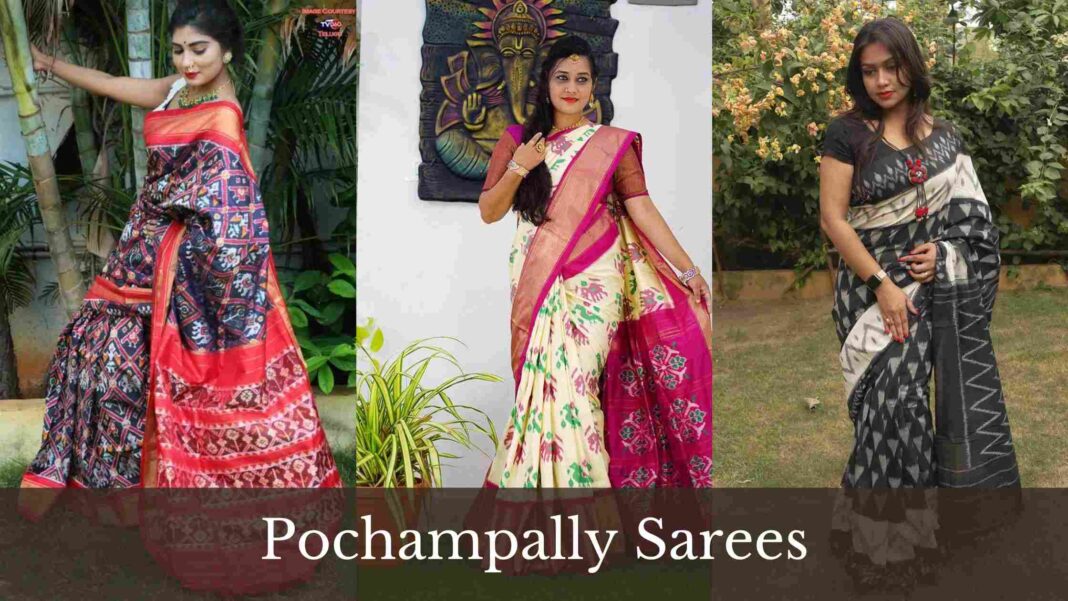Pochampally, an old-fashioned village in Telangana, is synonymous with the evergreen art of handloom weaving. The place is popular for its distinctive geometric patterns and vibrant colors that they successfully incorporate into their sarees, Pochampally sarees have earned a special place in the hearts of saree lovers and fashion enthusiasts globally and have become an irreplaceable part of Indian cultural heritage. Here we’ll look into the Pochampally saree origins.
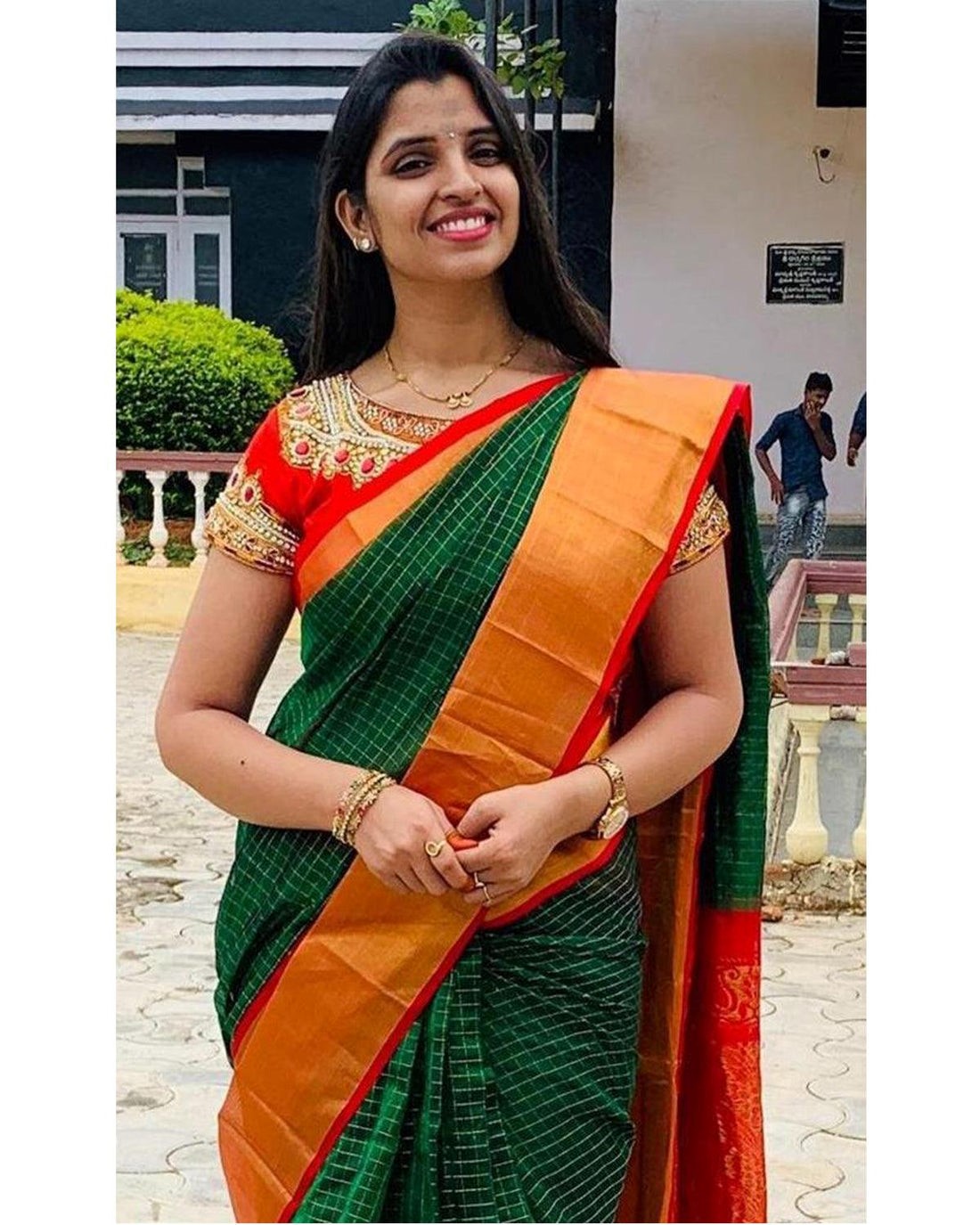
A Rich History of Pochampally saree:
Pochampally sarees are characterized by their distinct geometric designs, often termed as “Ikat.” This unique patterning is achieved through a detailed process dyeing and weaving. The yarns are tie-dyed before weaving them. It creates distinctive motifs that seem to blend seamlessly into the fabric. The result is a mesmerizing final outcome of colors and patterns. Every piece of this creation a statement to the skill and artistic mastery of the weavers.
The creation of a Pochampally saree is a hardworking process that requires skills, precision and expertise. The process begins with the selection of top-notch silk or cotton yarns. These yarns are then tied carefully and dyed in specific patterns. This process is known as “Ikat dyeing.” This step is important in many ways, as It has a direct impact on the final design of the saree.
Types of Pochampally sarees:
Pochampally sarees encompass a range of styles and designs, each with its unique characteristics. You may wonder what are the Pochampally saree types, so here they are segregated for you-
Single Ikat Sarees:
These sarees feature either warp or weft threads that are tie-dyed before weaving. The patterns on the saree are created by aligning the dyed threads with the undyed ones during the weaving process. It is a delicate process and the final outcome is gorgeous and loved by all. One of the most distinctive and striking aspects of Pochampally sarees is the wide variety of designs and color combinations available for you. From colorful, eye-catching colors to subtle, understated palettes, there’s a Pochampally saree to suit every kind of taste and occasion

Double Ikat Sarees:
Differing from the single ikat, in double ikat, both the warp and weft threads are tie-dyed before weaving. Getting a proper alignment of dyed threads in both directions requires exceptional skill and precision that the creators of this saree have already mastered through previous generations. These sarees are not only worn on special occasions but have also found a place in modern fashion, adapting to modern styles and trends, and have become a popular option for women even in the current times.
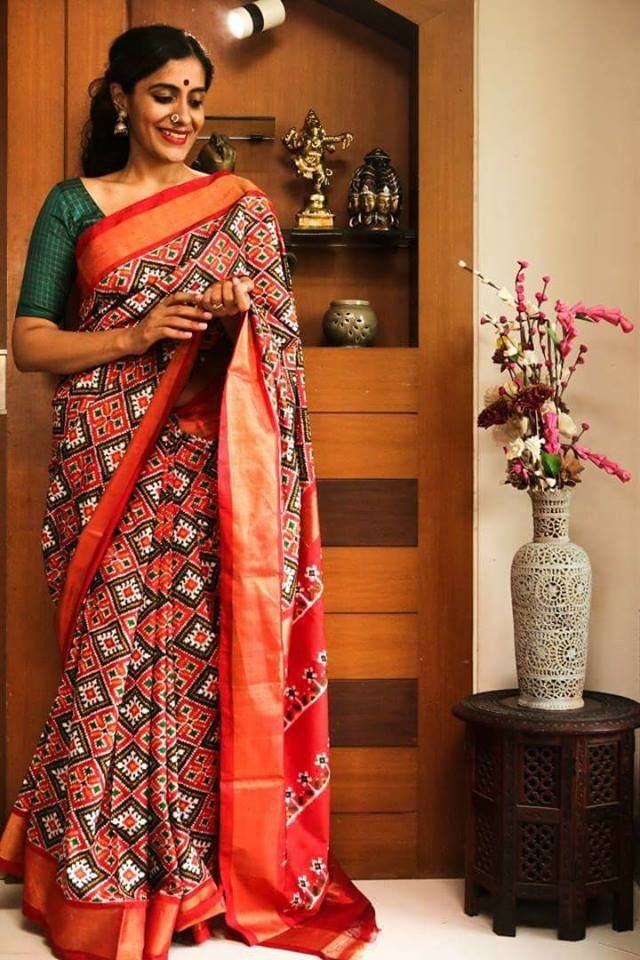
Silk Pochampally Sarees:
Made from pure silk, these sarees radiate a positive aura and are often chosen for special occasions and festivities. Given the wonderful and eye-catching design, it does not come as a surprise. The beautiful silk work complements the intricate ikat patterns in the most perfect way. Pochampally sarees not only showcase the artistic mastery of the weavers but also represent the cultural significance and tradition of the region. In recent times, efforts have been made to promote and preserve this cultural heritage.

Cotton Pochampally Sarees:
As you can already guess, Cotton Pochampally sarees are known for their comfort and porous nature. This makes these sarees the perfect wear for everyday use. They often use vibrant colors and detailed designs, adding a touch of elegance to everyday wear. The Government has taken initiatives, along with the support of various charities and organizations, who have played a crucial role in keeping the livelihoods of Pochampally weavers alive and making sure the tradition continues without any hassle and setbacks
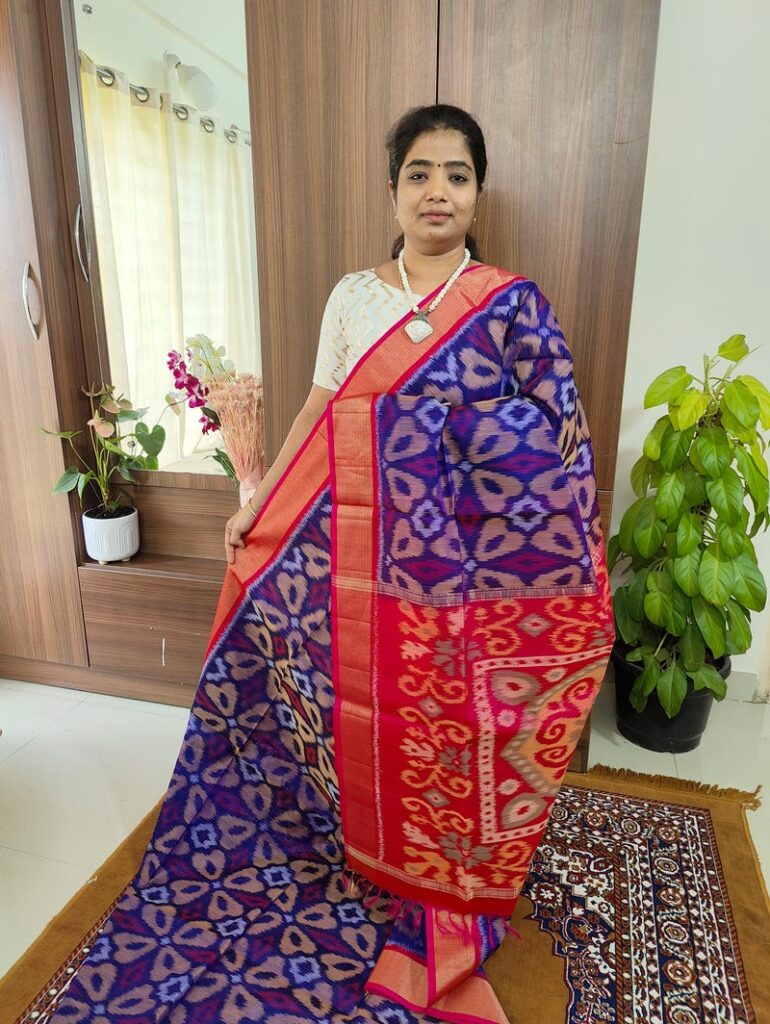
Mercerized Cotton Pochampally Sarees:
Mercerized cotton is a special type of material and it undergoes a specialized treatment that increases its sheen, strength, and color absorption properties. These sarees combine the comfort of cotton with a subtle elegance, making them versatile choices for different kinds of occasions. Pochampally sarees stand as a representation of the long-lasting age-old mastery and skill of Indian saree weavers. Their distinctive designs and vibrant colors have captured the attention of fashion enthusiasts around the world and have made it popular once again in modern times.
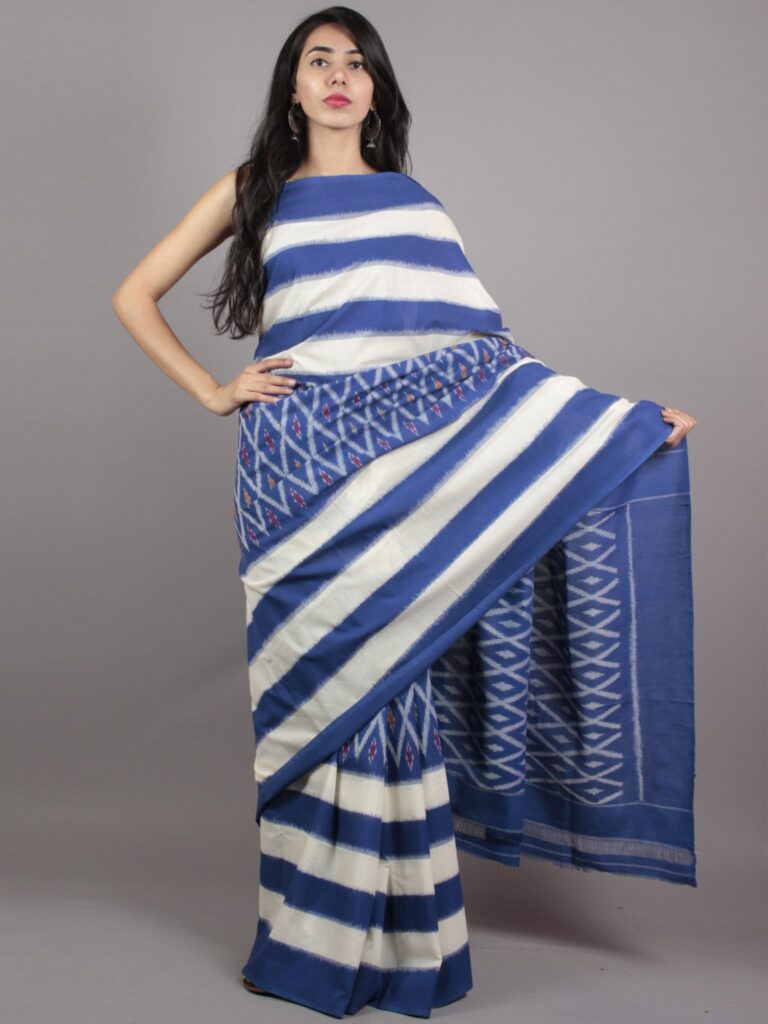
Temple Border Pochampally Sarees:
You know that these designs will be there when you’re looking at Indian sarees. These sarees are decorated beautifully with elaborate temple designs along their borders, adding a traditional touch to the overall outlook. The temple motifs often feature great details, showcasing the craftsmanship of the creators. This is a popular traditional design. As we indulge into the legacy of Pochampally sarees, it is essential to recognize and support the artists who continue to create these gorgeous pieces of art, ensuring that this tradition continues for future generations to see and appreciate.

Kanchi Border Pochampally Sarees:
These sarees incorporate Kanchipuram silk borders, known for their grand details and royal looks. The combination of the Pochampally body and the Kanchi border creates a contrast, making them popular choices for weddings and other festivities. It is a great choice overall. The history of Pochampally sarees goes back several centuries, with roots lying deep in the detailed craftsmanship of the creators. These sarees have been a part of the cultural heritage of India for generations, passing down the legacy of weaving from one skilled artisan to the next through generations.
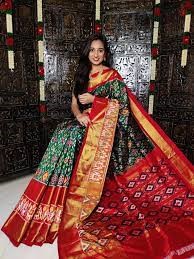
Patola Style Pochampally Sarees:
Inspired by the famous Patola designs of Gujarat, these Pochampally sarees incorporate the double ikat technique of Patola weaving. They have rich, symmetrical designs that require a lot of precision during the making process. Once the dyed yarns are ready, they are set up on the loom, and the weaving process begins. The weaver skillfully creates the design, attentive to every thread to ensure the patterns align perfectly.
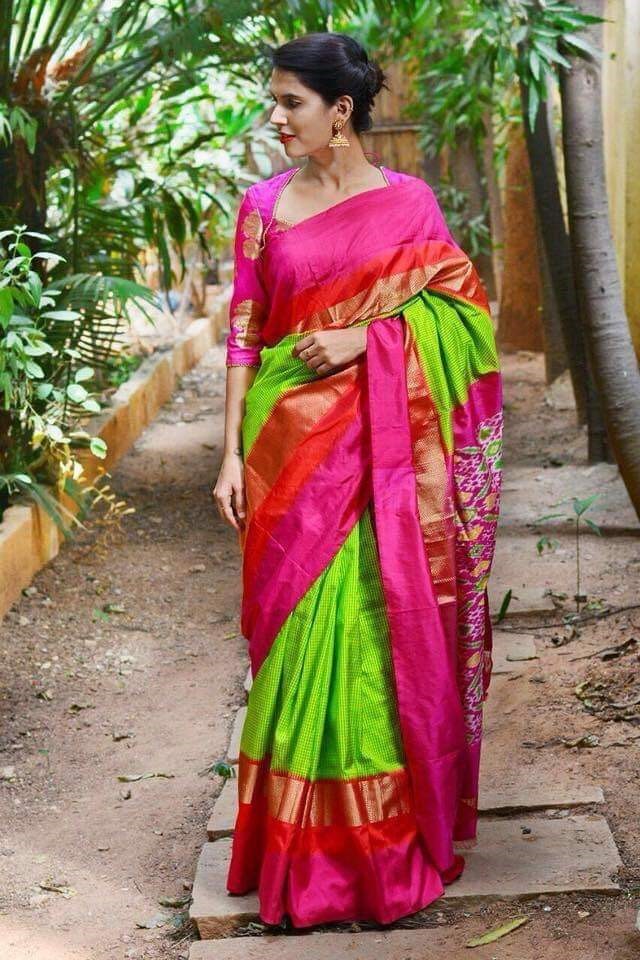
Contemporary Designs:
In modern times, Pochampally weavers have experimented with modern and fusion designs, incorporating elements like floral motifs, abstract patterns, and contemporary color palettes to cater to evolving fashion trends and desires of the new-age consumer. Fusion has become a part of fashion evolution and adaptability and is an important part of every fashion. It is a humble representation of Indian heritage and craftsmanship. You can look into more details with Pochampally saree images and have a look yourself at the detailing and mastery the craftsmen have achieved.
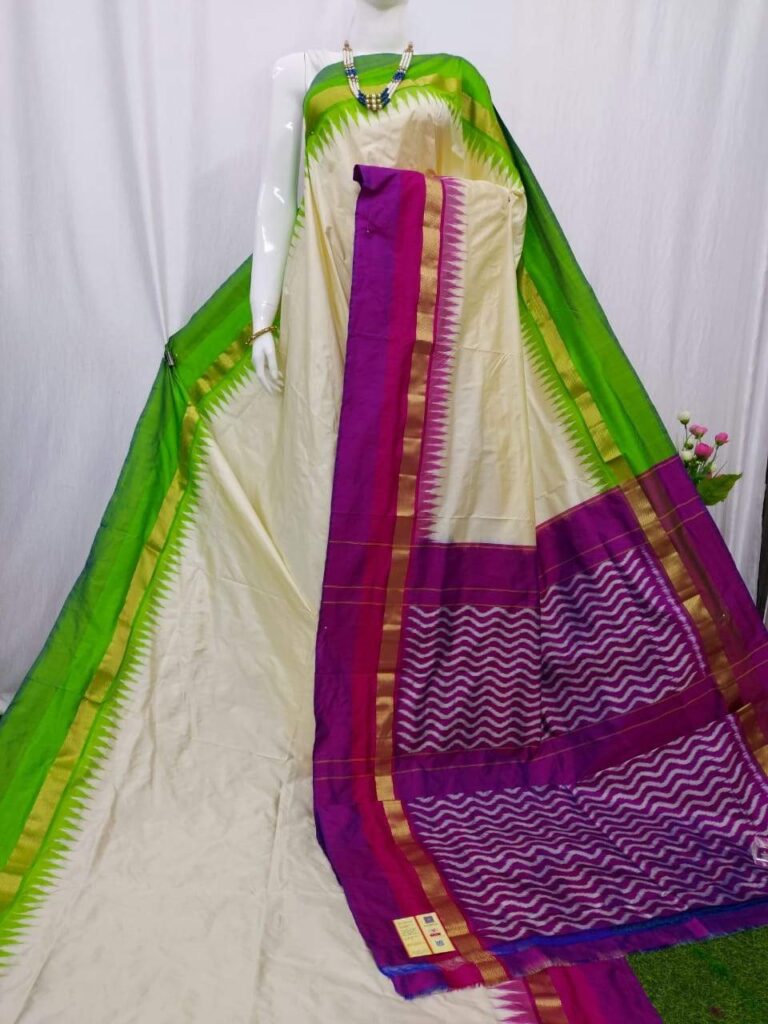
Kupadam Sarees:
Kupadam sarees are a type of Pochampally sarees, known for their distinct style and weaving techniques. They often feature unique patterns and color combinations That can attract people and fix their eyes on the dress. This delicate process can take up a lot of time, sometimes even days or even weeks, depending on the detailing and intricacy of the design and the size of the saree.
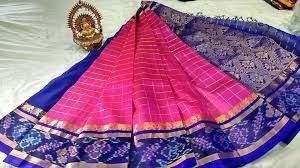
These various types of Pochampally sarees showcase the versatile nature of the saree and the artistry of the weavers, making them an important part of India’s textile heritage and tradition. Whether it’s for a traditional celebration or a contemporary representation, there’s a Pochampally saree to suit everyone’s taste.
Price of Pochampally sarees:
The prices of Pochampally sarees can vary widely and it depends on a lot of factors, including the type of saree, the materials used (silk or cotton), the detailing of the weaving, the design, and any additional embellishments. If you want a rough idea on the price of Pochampally sarees, this will give you some knowledge:
Cotton Pochampally Sarees:
Basically, everyday cotton Pochampally sarees can start from around ₹1,000 to ₹3,000. However, if you are looking for Finer and more intricately woven cotton sarees, the price may range from ₹3,000 to ₹8,000.
Silk Pochampally Sarees:
Pure silk Pochampally sarees are generally more expensive due to the premium quality of the silk. Prices for silk Pochampally sarees can start from ₹5,000 and can go up to a lot depending on factors like the quality of the silk used and the detailing used in the design. Some premium silk variants can cost upwards of ₹20,000 and even more.
Double Ikat Pochampally Sarees:
Double ikat Pochampally sarees, due to the intricate weaving process, tend to be on the higher side of the price chart. Prices for double ikat Pochampally sarees can lie in the range from ₹8,000 to ₹30,000 or more, depending on various factors like the type of material (silk or cotton) and the level of detailing and embellishments.
Specialty Variants (Temple Border, Kanchi Border, Patola Style, etc.):
Specialty variants with unique features like temple borders, Kanchi borders, or Patola-style patterns can be priced higher as expected and it is completely justified. These unique sarees can range from ₹10,000 to ₹50,000 or more, depending on the intricacy of the design and the materials used in the making process.
Contemporary Designs:
These Sarees with modern or fusion designs may also vary in price depending on factors like the complexity of the design, materials used, and any additional embellishments. These require a lot of creativity and precision to create. Prices for contemporary Pochampally sarees can range from ₹3,000 to ₹20,000 or more depending on your desire and choice.
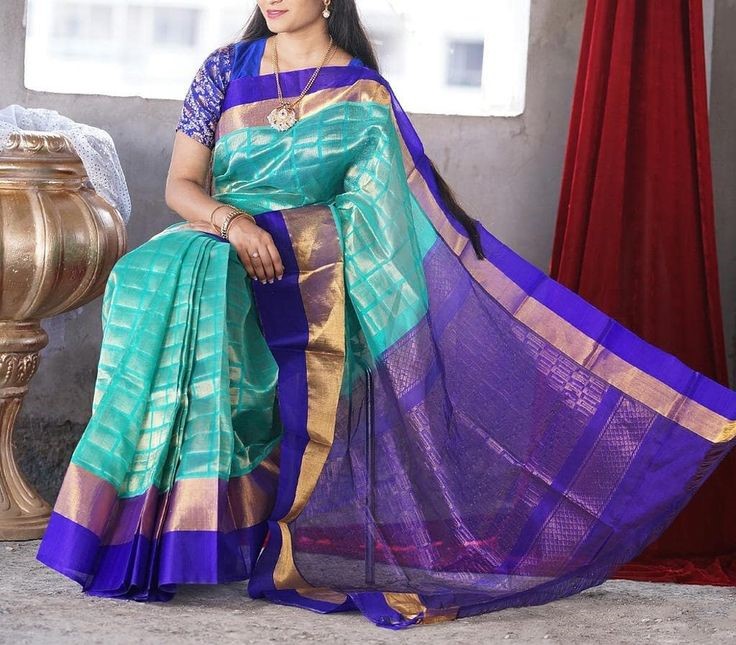 It’s important to know that these are approximate price ranges, and actual prices may vary depending on different things like location, the reputation of the weaver or brand, and market demand. When purchasing a Pochampally saree, it’s recommended to get it from more reputable sources to be a hundred percent sure about the product and get authentic Pochampally sarees.
It’s important to know that these are approximate price ranges, and actual prices may vary depending on different things like location, the reputation of the weaver or brand, and market demand. When purchasing a Pochampally saree, it’s recommended to get it from more reputable sources to be a hundred percent sure about the product and get authentic Pochampally sarees.
Frequently asked questions:
- Which sarees are famous in Pochampally?
The most famous sarees in Pochampally are the ones that feature the famous and unique Ikat weaving technique. This includes both single and double Ikat sarees. They are known for their beautiful geometric patterns and vibrant colors. Pochampally sarees can be made from both silk and cotton, offering a plethora of options for buyers.
- What is the difference between Pochampally and Patan Patola?
Both Pochampally and Patan Patola sarees are known for their highly detailed Ikat patterns, but they originate from different regions in India. Pochampally sarees are from the village of Pochampally in Telangana, whereas Patan Patola sarees are from the town of Patan in Gujarat. The region makes the crafts different although both incorporate similar designs and weaving techniques.
The key distinction is that Patan Patola sarees are made using a double Ikat technique, where both warp and weft threads are tie-dyed before weaving. Pochampally sarees, on the other hand, can be single Ikat (either warp or weft threads are dyed) or double Ikat. Patan Patola sarees are identified by their rich, symmetrical patterns, while Pochampally sarees often feature a wide range of geometric designs. The minor differences in design make both of these unique.
- What is the difference between Ikat and Pochampally?
“Ikat” is a general term for a dyeing and weaving technique where threads are tie-dyed before being woven into fabric, creating intricate patterns. It’s a technique that is used in various regions around the country. “Pochampally” specifically refers to the Ikat weaving tradition of the village Pochampally in Telangana, India. Pochampally sarees are a type of Ikat saree that originates from this village. Pochampally is a more specific term given to a region whereas ikat is the more generalized and used term for the technique.
- Which silk saree is famous in Telangana?
– The famous silk saree in Telangana is the “Pochampally Saree” and the “Gadwal saree”. The Gadwal sarees are known for their fine silk texture, contrasting borders, and distinctive “Kootu” (Pallu) design. Gadwal sarees are traditionally woven in the town of Gadwal in Telangana whereas Pochampally sarees are made in Pochampally. Both are highly regarded for their craftsmanship and elegance. They are a popular choice for special occasions and celebrations in the region.
What we see from these types of designs and craftsmanship is that we need to support these artists and make sure they are valued and their traditions are kept alive. These are the traditions and fashions that need to be preserved and have the potential to represent our textile heritage for generations to come.


